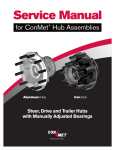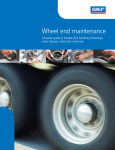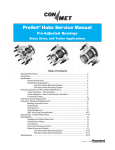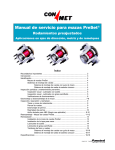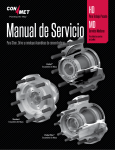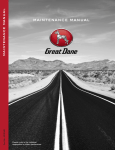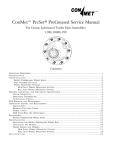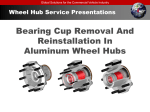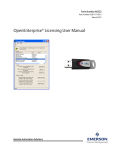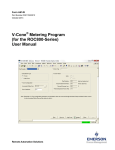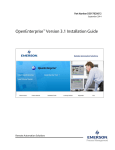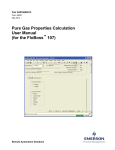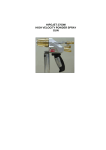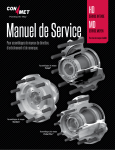Download Service Manual
Transcript
Service Manual HD H EAVY for PreSet® Hub Assemblies PreSet® Hubs for Drum Brakes Australian Operating Environment Only Aluminum PreSet® Hub Assembly DUTY Iron PreSet® Hub Assembly Pre-Adjusted Bearings ABOUT THIS MANUAL Read this manual carefully, providing extra attention to its explanations and instructions. About This Manual To ensure safe, continuous, trouble-free operation, understand your wheel hub system, and keep all components in proper operating condition. Pay particular attention to all NOTES, CAUTIONS, WARNINGS, and DANGERS to avoid the risk of personal injury or property damage, and realize these statements are not exhaustive. ConMet cannot possibly know or evaluate all conceivable methods in which service may be performed or the possibly hazardous consequences of each method. Accordingly, those who use a procedure not recommended by ConMet must first satisfy themselves that neither their safety nor the safety of the product will be jeopardized by the service method selected. Use only ConMet approved replacement parts. Do not attempt to use damaged parts. DISC WHEEL INSTALLATION PROCEDURES (ConMet part number 103282), OIL DECALS (ConMet part number 106873), and SEMI-FLUID DECALS (ConMet part number 107383) are available upon request. Before You Begin 1. Read and understand all instructions and procedures before you begin to service components. 2. Read and observe all Warning and Caution hazard alert messages in this publication. They provide information that can help prevent serious personal injury, damage to components, or both. 3. Follow your company’s maintenance and service, installation, and diagnostics guidelines. 4. Use special tools when required to help avoid serious personal injury and damage to components. Hazard Alert Messages A danger note is associated with a hazard that will result in death or serious personal injury if the advisory is not followed. Serious personal injury may be equated to career-ending injury. A Warning alerts you to a hazard that will result in death or serious injury if not avoided. A Caution alerts you to an instruction or procedure that you must follow exactly to avoid minor injury or damage to components. A note includes additional information that may assist the technician in service procedures. How to Obtain Additional Maintenance and Service Information On the Web Visit www.conmet.com to access ConMet’s product, sales, service and maintenance literature. ConMet Customer Service Call ConMet’s Customer Service at 1-800-547-9473. NOTES Notes Consolidated Metco, Inc. TABLE OF CONTENTS Table of Contents 1. INTRODUCTION ........................................................................................................ 1 PreSet Hub Assemblies ...................................................................................... 1 2. IDENTIFICATION ........................................................................................................ 2 WHEEL MOUNTING SYSTEMS ................................................................................. 2 Hub Pilot Wheel Mounting ....................................................................................... 2 Ball Seat Wheel Mounting System .......................................................................... 2 IDENTIFYING CONMET HUB ASSEMBLIES ............................................................ 2 Vehicle Identification Number (VIN) ........................................................................ 2 Casting Number ...................................................................................................... 2 Machining Assembly Number ................................................................................. 2 Final Hub Assembly Number .................................................................................. 3 Julian Date .............................................................................................................. 3 3. INSPECTION .............................................................................................................. 4 HAZARD ALERT MESSAGES .................................................................................... 4 INSPECTION GUIDELINES ....................................................................................... 4 Driver Pre-Trip Visual Inspection ........................................................................ 4 Preventative Maintenance Schedule ................................................................... 4 Every 12 Months or 100,000 Miles (Whichever Occurs First) ............................. 4 Preparation .......................................................................................................... 4 Inspect Components ........................................................................................... 5 Inspect for Leaks ................................................................................................. 5 Inspect for Proper Lubricant Level and Condition ............................................... 5 Functional Checks ............................................................................................... 5 Check End Play ................................................................................................... 5 4. RECOMMENDED SERVICE ...................................................................................... 6 HUB REMOVAL AND DISASSEMBLY ....................................................................... 6 COMPONENT INSPECTION AND REPLACEMENT HAZARD ALERT MESSAGES ................................................................................ 7 CLEAN AND DRY COMPONENTS ............................................................................ 7 Worn or Damaged Components ............................................................................. 7 Hub and Component Cleaning ................................................................................ 7 INSPECTING BEARING CUPS, CONES AND SPACER ........................................... 9 REMOVING CUPS IN ALUMINUM HUBS .................................................................. 9 REMOVING CUPS IN IRON HUBS ............................................................................ 9 INSTALLING A NEW CUP IN ALUMINUM HUBS ...................................................... 9 INSTALLING A NEW CUP IN IRON HUBS ................................................................ 9 WHEEL STUDS .......................................................................................................... 9 STUD REMOVAL ........................................................................................................ 9 STUD REPLACEMENT ............................................................................................ 10 HUB, DRUM AND WHEEL INSPECTION ................................................................ 10 ABS TONE RING INSPECTION (AS APPLICABLE) ................................................ 10 REMOVAL AND INSTALLATION OF POWDERED METAL ABS TONE RING .................................................................................................. 10 REMOVAL AND INSTALLATION OF STAMPED STEEL ABS TONE RING .................................................................................................. 11 5. REASSEMBLY ......................................................................................................... 12 PreSet WHEEL HUBS .............................................................................................. 12 6. REINSTALLATION ................................................................................................... 14 INSTALLING THE PreSet WHEEL HUB ASSEMBLY .............................................. 14 Spindle Preparation ............................................................................................... 14 Mounting the Hub .................................................................................................. 14 Spindle Nut Torque ............................................................................................... 14 DRIVE HUB LUBRICATION ..................................................................................... 15 STEER AND TRAILER HUBS WITH OIL LUBRICANT ............................................ 15 TRAILER HUBS WITH SEMI-FLUID GREASE LUBRICANT ................................... 15 TABLE OF CONTENTS REINSTALLING BRAKE DRUMS AND WHEELS .................................................... 16 Hub Pilot Wheel Mounting System ........................................................................ 16 Ball Seat Wheel Mounting System ........................................................................ 18 SERVICE PARTS LIST ................................................................................................ 20 SPECIFICATIONS ........................................................................................................ 22 Wheel End Torque Specifications ....................................................................... 22 1. INTRODUCTION Consolidated Metco, Inc. is recognized as the leader in the design and manufacture of lightweight/low maintenance components for the commercial vehicle industry. ConMet PreSet wheel hub technology offers a better solution to prevent premature wheel hub failures. 5Introduction 3 PreSet Hub Assemblies ConMet PreSet hub assemblies include precision-machined hubs, premium seals, specially toleranced roller bearings and unique precision-machined bearing spacers. This combination eliminates the need to manually adjust wheel end play. These components are delivered as a complete assembly, reducing the potential for premature failures due to incorrect end play settings and/or improper installation practices. 106818a PreSet Drive Hub FIGURE 3 4 1 LUBRICANT FILL ABS RING PLUG (OPTIONAL) OIL SEAL 106819a INNER BEARING CONE INNER BEARING CUP PreSet TN Trailer Hub FIGURE 4 5 SPACER (SECTIONED) OUTER BEARING OUTER CONE BEARING CUP 106817a FIGURE 1 ConMet offers a complete family of aluminum and ductile iron PreSet wheel hub assemblies for steer, drive and trailer axles. 106820a PreSet TP Trailer Hub FIGURE 5 2 106304a PreSet Steer Hub FIGURE 2 1Consolidated Metco, Inc. 1 Consolidated Metco, Inc. 2. IDENTIFICATION WHEEL MOUNTING SYSTEMS IDENTIFYING CONMET HUB ASSEMBLIES ConMet PreSet wheel hubs are available in both hub pilot and ball seat nut configurations. Identifying your hub assembly is important for many reasons. It will enable you to properly service the hub assembly and purchase the appropriate replacement parts if needed. Plus, if a warranty issue arises, you’ll then be able to provide details on all aspects of the ConMet hub. This section is devoted to finding and understanding the different identification numbers associated with ConMet hubs. Identification Hub Pilot Wheel Mounting The hub pilot wheel mounting system makes use of a single two-piece flange nut on each wheel stud for both single and dual wheel applications (see figure 6). The hub pilot wheel mounting system is also known as the Uni-Mount-10™ (10 stud), WHD-10™ (10 stud), WHD-8™ (8 stud), and ISO system. 6 SINGLE DUAL Vehicle Identification Number (VIN) The quickest and easiest method of identifying your hub assembly is to note the vehicle identification number (VIN) and call the truck dealership. The dealership can then tell you what hubs were installed on your vehicle. If this is not possible, there is a variety of identification numbers located on a ConMet hub assembly. Casting Number 106821a This number is physically cast into the hub and appears in large characters usually on the back side of the mounting flange near the stud head (see figure 8). 8 Hub Pilot Mounting Systems FIGURE 6 Ball Seat Wheel Mounting System The ball seat wheel mounting system makes use of the spherical contact area between the nut and wheel to both locate the wheel and hold the wheel tight against the brake drum (see figure 7). The ball seat wheel mounting system is also known as the stud piloted, ball seat cap nut (BCN) and double cap nut (DCN) system. 7 SINGLE CASTING NUMBER ON THE BACK SIDE OF THE MOUNTING FLANGE 106829a Casting Number on the Back Side of the Mounting Flange FIGURE 8 Machining Assembly Number DUAL This number is stamped on one of the following: Mounting flange face (see figure 9) Diameter of the mounting flange (see figure 10) Back side of the mounting flange (see figure 11) 106822a Ball Seat Mounting Systems FIGURE 7 2 Consolidated Metco, Inc. Barrel of the hub (see figure 12) The machining number represents the way the hub is machined (e.g., hub pilot vs. ball seat, 8.78" vs. 8.53" vs. 9" brake drum pilot diameter). Consolidated Metco, Inc. 2 2. IDENTIFICATION (CONTINUED) 9 12 MOUNTING FLANGE FACE BARREL OF HUB 106828a 106827a Mounting Flange Face FIGURE 9 Barrel of Hub FIGURE 12 10 Final Hub Assembly Number MOUNTING FLANGE DIAMETER This number is stamped on one of the following: Mounting flange face (see figure 9) Diameter of the mounting flange (see figure 10) Back side of the mounting flange (see figure 11) 106825a Mounting Flange Diameter FIGURE 10 The final hub assembly number identifies the hub assembly, hub machining, studs, bearings, spacer, seal and ABS ring. Julian Date 11 MOUNTING FLANGE BACKFACE Both the machining and the final assembly have Julian dates stamped into the hub assembly in the same location as the assembly numbers (see figures 9, 10, 11 and 12). A Julian date appears as the day of the year plus the last two digits of the calendar year (e.g., July 4 2008 would appear as 18508). This number provides the date when the hub was machined and assembled at the factory and may be used for warranty purposes. 106826a Mounting Flange Backface FIGURE 11 3Consolidated Metco, Inc. 3 Consolidated Metco, Inc. 3. INSPECTION HAZARD ALERT MESSAGES 2. Preventative Maintenance Schedule Read and observe all Warning and Caution hazard alert messages in this publication. They provide information that can help prevent serious personal injury, damage to components, or both. Wheel end inspections should be conducted during any routine preventative maintenance on the vehicle. Inspection Do not work under a vehicle supported only by jacks. Jacks can slip and fall over. Serious personal injury and damage to components can result. To prevent serious eye injury, always wear safe eye protection when you perform vehicle maintenance or service. Park the vehicle on a level surface. Block the wheels to prevent the vehicle from moving. Support the vehicle with safety stands. INSPECTION GUIDELINES Operating temperature can be checked as the vehicle enters the service area following a normal run. If the hub is running in excess of 150°F above the ambient in normal operating conditions, service is required. There are three levels of inspection criteria for PreSet hub assemblies: Driver pre-trip In conjunction with preventative maintenance schedule 1. Check all items listed in the driver pre-trip visual inspection. 2. Lift and support the axle and rotate the wheel. Check that the wheel rotates freely. Listen and feel for any signs of rough bearing operation or vibration. 3. On oil-lubricated steer and trailer hubs, place a magnet through the hubcap fill plug into the lubricant. Check for any signs of metal picked up by the magnet. 4. Push and pull on top of the tire or use a pry bar to lift the bottom of the tire to check for loose bearings or “chucking”. If any of the above conditions are found, the vehicle should be placed out of service until the item can be repaired. 3. Every 12 Months or 100,000 Miles (Whichever Occurs First) Preparation Every 12 months or 100,000 miles (whichever comes first) Vehicles on jacks can fall, causing serious personal injury or property damage. Follow this schedule of inspection and maintenance for PreSet hub assemblies. 1. Driver Pre-Trip Visual Inspection (Each time prior to operating the vehicle on the road) With vehicle parked on level ground and the parking brake set, walk around the vehicle and visually inspect each wheel assembly for the following items: Loose, damaged or missing fasteners Never work under a vehicle supported by a jack without supporting the vehicle with stands and blocking the wheels. Wear safe eye protection. 1. Park the vehicle on a level surface. Block the wheels to prevent the vehicle from moving. 2. Raise the axle until the tires are off the floor. 3. Place safety stands under the trailer frame or under each axle spring seat (see figure 13). 13 Loose, damaged or missing hubcaps Oil leaks at hubcap, axle flange gasket or fill plug Lubricant on the hub, brake components or inside of wheel and tire Insufficient oil level and poor oil condition If any of the above conditions are found, the vehicle should be placed out of service until the item can be repaired. 4 Consolidated Metco, Inc. 1003159a FIGURE 13 Consolidated Metco, Inc. 4 3. INSPECTION (CONTINUED) 4. Remove the tire and wheel assembly using procedures specified by the wheel manufacturer (see figure 14). On wheel ends filled with semi-fluid grease, remove the hubcap and verify that sufficient grease is flowing through the bearing rollers and that the ends of the bearing are lubricated. Check to be sure there are no signs of contamination present. If additional grease is required, use the fill hole in the barrel of the hub to add additional grease until grease flows from the outboard bearing. Use caution not to overfill the hub as it could lead to improper venting and seal leaks. 14 Functional Checks Rotate the hub and check for free, smooth, and quiet rotation. If rotation is hampered, PreSet hubs should be serviced immediately. 103160a FIGURE 14 Inspect Components Check for the following: Loose, damaged or missing fasteners Loose, damaged or missing hubcaps Check End Play 1. Remove the hubcap or drive axle shaft. Use an appropriate container to catch the lubricant. Attach the magnetic base of the dial indicator to the spindle. Touch the dial indicator stem to the hubcap mounting surface (see figure 15). 15 Inspect for Leaks 1. Check that no lubricant is present around the hubcap or on the wheel. If lubricant is present, investigate the cause and take corrective action. 2. Check that no lubricant is present on the hub, brake hardware or brake shoes. If lubricant is present, check the inboard seal and replace as necessary. 105735a FIGURE 15 Inspect for Proper Lubricant Level and Condition 2. Grasp two wheel studs across from each other. Pull and push while oscillating the hub. 1. Allow any air in the lubricant to escape prior to inspection. Visually inspect the lubricant for discoloration. Under normal conditions, the lubricant will darken. A white or milky appearance indicates water contamination. 3. Measure the end play by calculating the difference between the minimum and maximum dial indicator readings. Unless the end play measurement exceeds .006", no additional service is necessary. If the spindle nut is correctly locked, do not adjust or retighten the spindle nut. 2. Visually inspect the lubricant for foreign materials such as metal shavings, rust or other contaminants. A magnet can be used to detect any metallic materials that may be present in the lubricant. 3. If the inspection indicates contamination, service the wheel hub according to instructions outlined later in this manual. If end play exceeds 0.006-inch (0.15 mm), service the hub. All components replaced under warranty must be returned for consideration of reimbursement. Contact the OEM for their warranty return policy. Do not mix different types of lubricants. Only use lubricants approved by the seal manufacturer. For a complete list, refer to the Lubricant Compatibility Listing in the Literature section on www.conmet.com. 5Consolidated Metco, Inc. 5 Consolidated Metco, Inc. 4. RECOMMENDED SERVICE The recommended service interval is 5 years/ 500,000 miles or every second brake service for on-highway vocations. In more severe duty applications, this service may be required more often. Your 12 month inspection criteria will give you an indication whether this service is required. Recommended Service If the hub to be disassembled is a drive hub, remove the drive axle shaft, and capture the oil (see figure 17). 17 In order to ensure optimum wheel hub performance, ConMet recommends that only approved PreSet service parts be used to replace all critical components of the system. Refer to the back of this manual for a listing of approved parts. HUB REMOVAL AND DISASSEMBLY 1. Remove the tires and wheels by following steps 1-4 under the Inspection Guidelines section entitled “3. Every 12 Months or 100,000 Miles (Whichever Occurs First)” on page 4. Sudden release of compressed air can cause serious personal injury and damage to components. Before you service a spring chamber, carefully follow the manufacturer’s instructions to compress and lock the spring to completely release the brake. Verify that no air pressure remains in the service chamber before you proceed. 2. If the axle is equipped with spring brake chambers, carefully compress and lock the springs so that they cannot actuate (see figure 16). 106803a Removing the Drive Axle Shaft FIGURE 17 4. Place a container under the hubcap, or drive axle shaft for a drive hub, to receive the draining oil, then remove the hubcap or drive axle shaft. Do not reuse the oil. Correctly dispose of the lubricant. 5. Examine the spindle nut to determine the type of locking system. Disengage the locking device. Do not loosen the axle spindle nuts by either striking them directly with a hammer, or striking a drift or chisel placed against them. Damage to the parts will occur causing possible loss of axle wheel-end components and serious personal injury. 16 6. Remove the spindle nut system. 103161a FIGURE 16 3. Remove the brake drum. Support the drum during the removal process to prevent damage to the axle spindle threads. 6 Consolidated Metco, Inc. Consolidated Metco, Inc. 6 4. RECOMMENDED SERVICE (CONTINUED) 7. Slide the hub off the spindle. Remove and save the outer bearing cone. Be careful when you remove the hub that you do not damage the outer bearing by dropping it on the floor. If the hub is difficult to remove because the seal is stuck on the spindle, use a mechanical puller to remove the hub (see figure 18). If part of the seal remains on the spindle, carefully remove the part of the seal that remains on the spindle. 18 COMPONENT INSPECTION AND REPLACEMENT HAZARD ALERT MESSAGES Read and observe all Warning and Caution hazard alert messages in this publication. They provide information that can help prevent serious personal injury, damage to components, or both. To prevent serious eye injury, always wear safe eye protection when you perform vehicle maintenance or service. Observe all warnings and cautions provided by the press manufacturer to avoid damage to components and serious personal injury. Do not hit steel parts with a steel hammer. Pieces of a part can break off. Serious personal injury and damage to components can result. Use a brass or synthetic mallet for assembly and disassembly procedures. 105740a FIGURE 18 8. Place the hub on its outboard end and remove and discard the seal. 9. If present, remove and discard the inner bearing retainer. The stamped steel retainer secures the inner cone during shipment and has no purpose in service (see figure 19). Be careful not to damage the inner bearing and spacer during the removal process. Solvent cleaners can be flammable, poisonous and cause burns. Examples of solvent cleaners are carbon tetrachloride, and emulsion-type and petroleum-base cleaners. Read the manufacturer’s instructions before using a solvent cleaner, then carefully follow the instructions. Also follow the procedures below. Wear safe eye protection. You must use hot solution tanks or alkaline solutions correctly. Read the manufacturer’s instructions before using hot solution tanks and alkaline solutions. Then carefully follow the instructions. Wear clothing that protects your skin. Work in a well-ventilated area. Do not use gasoline or solvents that contain gasoline. Gasoline can explode. Do not use hot solution tanks or water and alkaline solutions to clean ground or polished parts. Damage to parts can result. 10. Remove the inner bearing and spacer. CLEAN AND DRY COMPONENTS 19 Worn or Damaged Components INNER BEARING RETAINER INNER BEARING CONE Do not repair or recondition wheel-end components. Replace damaged, worn or out-of-specification components. Do not mill or machine any components. Using repaired, reconditioned, damaged or worn components can cause wheel end failure, which can result in serious injury and property damage. SPACER 106804a Hub Disassembly (Inner Bearing Retainer is not on Hubs equipped with CR Seals) FIGURE 19 7Consolidated Metco, Inc. Hub and Component Cleaning 1. Use a cleaning solvent to clean the ground or polished parts and surfaces. Kerosene or diesel fuel can be used for this purpose. DO NOT USE GASOLINE. 7 Consolidated Metco, Inc. 4. RECOMMENDED SERVICE (CONTINUED) 2. Do NOT clean ground or polished parts in a hot solution tank or with water, steam or alkaline solutions. These solutions will cause corrosion of the parts. If you choose to reuse existing bearings at this service, they must be inspected in accordance with the bearing manufacturers recommended guidelines. 3. Thoroughly clean the hub cavity with spray degreaser. The cavity must be free of any contaminants. 4. To remove grease from a wheel end, use a stiff fiber brush, not steel, and kerosene or diesel fuel, not gasoline. Allow the parts to dry. Note that any solvent residue must be completely wiped dry since it may either dilute the grease or oil or prevent the lubricant from correctly adhering to the wheel-end components. 5. Clean and inspect the wheel bearings, race, spindle bearing and seal journals, and hub. Bearings should be cleaned in a suitable non-flammable solvent and dried with either compressed air or a lint-free rag. If this inspection indicates that existing bearing component(s) must be replaced, bearing cups and cones must be replaced as a set. Whenever new bearings are installed, replacement of the bearing spacer is also recommended. 2. After properly cleaning the components, visually inspect spacer for wear or damage. It can be difficult to determine if the spacer is worn and needs replacement. It is recommended that the spacer be replaced anytime the hub is disassembled and there is evidence of bearing cone rotation. Cone rotation can result in spacer wear. Therefore, if the spacer is reused, unsafe preload of the bearings could occur. To inspect for cone rotation: If compressed air is used, do not spin dry the bearings as the rollers may score due to lack of lubricant. Ensure that the air line is moisture free. 6. Parts must be dried immediately after cleaning. Dry parts with clean paper towels or rags, or compressed air. Do not dry bearings by spinning with compressed air. 7. Apply a light oil to cleaned and dried parts that are not damaged and are to be immediately assembled. Use only the type of oil used by the manufacturer. Do NOT apply oil to the brake linings or the brake drums. 8. If the parts are to be stored, apply a good corrosion preventative to all surfaces. Do NOT apply the material to the brake linings or the brake drums. Store the parts inside special paper or other material that prevents corrosion. INSPECTING BEARING CUPS, CONES AND SPACER 1. After components have been properly cleaned, visually inspect the cups and cones. Reference materials for proper inspection procedures are available from the bearing manufacturers. If removal or replacement is required, follow the steps outlined on the next page. 8 Consolidated Metco, Inc. Visually inspect spacers for signs of wear or damage. Carefully inspect the machined ends of the bearing spacer. Wear to the bearing spacer can appear as a sharp ring of standing metal at either edge of the machined surfaces (See figure 20). Inspect bearing cone ID for visual evidence of rotation and wear. Inspect spindle bearing journal for visual evidence of rotation and wear. 20 NEW WORN SHARP EDGE 106864a Bearing Spacer Wear FIGURE 20 If unsure of the condition of components, PreSet bearing kits can ensure bearing adjustment and optimum bearing life. The PreSet bearing kit consists of both bearing sets and a bearing spacer. The kits are available from both ConMet and approved bearing suppliers. Some kits also include a wheel seal. Consolidated Metco, Inc. 8 4. RECOMMENDED SERVICE (CONTINUED) REMOVING CUPS IN ALUMINUM HUBS 1. If required on an aluminum hub, remove the bearing cup by welding a large bead around the bearing surface of the steel cup, letting the assembly cool, and removing the bearing cup (see figure 21). If a welder is not available, heat the hub in an oven to a temperature not to exceed 300°F and pound out the bearing cups with a hammer and drift, being careful not to damage the hub. Do not overheat the hub as it may degrade the heat-treated strength of the hub. Remove the aluminum hub from the oven or water and carefully drop in the new bearing cup being certain it is fully seated. If the cup is loose, allow a few seconds for it to heat up and secure itself before moving the hub. Use a 0.001″ to 0.002″ feeler gauge to ensure the cup is fully seated against the shoulder of the bearing bore. INSTALLING A NEW CUP IN IRON HUBS 21 Iron hubs do not need to be heated for bearing cup installation. Press the bearing cup into the hub, being certain that it is fully seated (see figure 22). Use a 0.001″ to 0.002″ feeler gauge to ensure the cup is fully seated against the shoulder of the bearing bore. 22 106856a 105742a Welding Bead FIGURE 21 2. Inspect the bearing cup bore for evidence of cup rotation or spun cups. If cup rotation exists, replace the hub. REMOVING CUPS IN IRON HUBS 1. On an iron hub, remove the bearing cup using a large hammer and a heavy drift or a hydraulic press. Take precaution to avoid damaging the bearing cup bore and shoulder. 2. Inspect the bearing cup bore for evidence of cup rotation or spun cups. If cup rotation exists, replace the hub. INSTALLING A NEW CUP IN ALUMINUM HUBS To install a new cup in an aluminum hub, it is recommended that the hub be heated in boiling water (212°F) or in an oven at a temperature not to exceed 300°F. Cooling the cup in a freezer to 32°F or below will further ease the installation, if desired. 9Consolidated Metco, Inc. Bearing Cup Pressed into Hub FIGURE 22 WHEEL STUDS Replace all wheel studs that have damaged or distorted threads, are broken or bent, or are badly corroded. Also, replace both studs adjacent to the damaged stud. If two or more studs have damage, replace all the studs in the hub. Broken studs are usually an indication of excessive or inadequate wheel nut torque. STUD REMOVAL Observe all warnings and cautions for press operation provided by the press manufacturer to avoid serious personal injury and damage to components. 1. Place the clean hub in a shop press with the hub supported evenly around and adjacent to the stud being removed. 9 Consolidated Metco, Inc. 4. RECOMMENDED SERVICE (CONTINUED) Failure to adequately support the hub can result in physical injury and/or damage to the hub. Some hubs are configured so it is impractical to have supports to prevent the hub from tipping when force is applied to the stud. In this case, support the hub on wood blocks on the floor and use a heavy hammer to drive the studs out with several sharp blows. Be careful to avoid damaging the hub and components, particularly the seal bore and the ABS tone ring. 2. Press the stud out of the hub. ABS TONE RING INSPECTION (AS APPLICABLE) The Anti-Lock Braking System (ABS) signals acts like any signal generator where the magnet passes a coil and generates a current. On hubs, the toothed ring passes a sensor and generates a signal that is sent to the ABS computer. There are two types of ABS rings used on ConMet hubs — powdered metal and stamped steel (see figure 23). 23 STUD REPLACEMENT On the ball seat wheel mounting system, always use left-handed threaded studs on left-handed hubs, and use right-handed threaded studs on right-handed hubs. The ConMet part number is located on the head of the stud. The same part number must be used for replacement unless changing the drum or wheel type. 1. To install a new stud, support the hub evenly around and adjacent to the stud being installed. 2. Press the new stud all the way into the hub. Be sure the stud is fully seated and that the stud head is not embedded into the hub. Excessive force can cause the stud head to be embedded into the hub, which can create a crack in the hub, resulting in serious injury and property damage. If a stud head is imbedded in a hub, replace the hub. POWDERED METAL (OR MACHINED) ABS RING STAMPED STEEL ABS RING 106805a FIGURE 23 If the tone ring is damaged (for example, if it is dropped, bent, chipped or dinged), it must be replaced. REMOVAL AND INSTALLATION OF POWDERED METAL ABS TONE RING For a powdered metal ring, remove using a chisel, making sure not to damage the hub. Reinstall by heating the ring to 350°F in an oven and installing it on the hub (see figure 24). 24 HUB, DRUM AND WHEEL INSPECTION 1. Inspect the drum pilots, wheel pilots, and mounting face on the hub for damage. A damaged drum pilot is usually caused by improper drum mounting. A damaged wheel pilot could be the result of inadequate wheel nut torque, allowing the wheels to slip in service. Also, inspect other surfaces of the hub for signs of cracks or damage. 106806a 2. Inspect the wheels and brake drum for damage. Powdered Metal ABS Ring FIGURE 24 Do not repair or recondition wheel-end components. Replace damaged, worn or out-of-specification components. Do not mill or machine any components. Using repaired, reconditioned, damaged or worn components can cause wheel end failure, which can result in serious injury and property damage. 10 Consolidated Metco, Inc. Consolidated Metco, Inc. 10 4. RECOMMENDED SERVICE (CONTINUED) REMOVAL AND INSTALLATION OF STAMPED STEEL ABS TONE RING 1. The steer axle tone ring can be removed by gripping the ring with a pair of locking pliers and tapping the pliers upward with a rubber mallet. Work around the ring to keep the ring from cocking (see figure 25). Drive axle and trailer tone rings can be removed by gripping the ring with a pair of locking pliers and prying against the head of a wheel stud to lift the ring off the hub. Work around the ring to prevent cocking (see figure 26). 4. Using ConMet ring installation tool (part number 107119), center the tool over the ABS ring. Each type of ring fits a corresponding diameter on the tool (see figure 27). 27 25 106807a 105744a Stamped Steel ABS Ring on Steer Axle FIGURE 25 Installing the ABS Tone Ring FIGURE 27 26 5. Press the ring on the hub. If a press is not available, drive the ring on with a hammer or mallet until the ring seats on the hub (see figure 28). A swift initial blow with an 8-lb. hammer may be necessary to start the ring onto the hub. 28 106808a Stamped Steel ABS Ring on Drive Axle FIGURE 26 2. Thoroughly clean and degrease the ABS ring seat on the hub with a nonflammable solvent. Replace the hub if the ABS ring seat is damaged. The ABS ring must be fully seated with a maximum of 0.008″ axial runout to ensure the ABS system functions properly. For steer hubs, be certain the inside diameter flange is facing up. 3. Place the hub in a press and place the ABS ring on the hub ring seat. Consolidated Metco, Inc. 11 105745a Using a Hammer to Install the Ring FIGURE 28 6. Inspect the ring to ensure proper seating. If the ring is not completely seated, continue to drive the ring with the ring installation tool until it is completely seated. 11 Consolidated Metco, Inc. 5. REASSEMBLY PreSet WHEEL HUBS Reassembly The seal must be replaced every time the hub is removed from the spindle. When using an oil bath system, do not pack the bearing with grease. Grease will prevent the proper circulation of axle lubricant and can cause premature wheel seal and bearing failure. 1. Place the hub, seal end up, on a clean work bench surface. Do not apply any gasket sealant to the seal outer or inner diameter. Always use the seal installation tool specified by the seal manufacturer. Using an improper tool can distort or damage the seal and cause premature seal failure. If using the Outrunner wheel seal, place the seal with the “air side” facing the adapter plate of the installation tool. If using the SKF Scotseal Plus XL wheel seal, no special installation tools are required. If you are working on a drive or trailer hub, go to step 3. If you are working on a steer hub, proceed as follows. 2. For steer hubs, install the tubular bearing spacer with the tapered end down (see figure 28). 28 If using the Stemco Endeavor seal, be sure to use the Stemco installation tool. 4. When installing the SKF or Outrunner wheel seal, lubricate the seal outer diameter and the hub seal bore with the same lubricant as will be used in the hub. The Stemco Endeavor seal is installed dry and should not be lubricated. 5. Position the seal into the hub bore. The Outrunner and Stemco Endeavor seals require the proper tool for installation. Refer to the Service Parts List on page 20 of the manual to identify the correct installation tool. 106809a Bearing Cone Assembly for Steer Hub FIGURE 28 3. Lubricate the inner bearing cone with the same lubricant as will be used in the hub and install it into the inner bearing cup (see figure 29). 29 6. When installing the Outrunner or Stemco Endeavor seal, tap the adapter plate of the installation tool around the outer edge to postition the seal. Drive the wheel seal into place (see figure 30). Once the tool bottoms out, the seal is installed correctly. 7. When installing the SKF Scotseal Plus XL, press the seal evenly into the bore by hand (see figure 30). If additional force is needed, use a flat plate and a small mallet to install the seal. Install the seal. 106810a Bearing Cone Assembly for Drive Hub FIGURE 29 12 Consolidated Metco, Inc. Consolidated Metco, Inc. 12 5. REASSEMBLY (CONTINUED) 11. Lubricate the outer bearing cone with the same lubricant as will be used in the hub and install it into the hub assembly (see figure 32). 30 32 OUTRUNNER OR STEMCO ENDEAVOR SEAL SKF SCOTSEAL PLUS XL 106811b FIGURE 30 8. Check to be certain the seal is not cocked and that the seal inner diameter and the inner bearing turn freely. 105749a Installing the Outer Bearing Cone FIGURE 32 Failure to lubricate the inner diameter of the seal, and the seal journal, may result in premature seal failure. 9. Lubricate the inner diameter of the seal with a light film of the same lubricant as will be used in the hub. 10. Turn the hub over, and place it seal end down. For all drive and trailer hubs, install a bearing spacer. If the spacer has a tapered end, it should face towards the outboard end of the hub (see figure 31). 31 105748a Installing the Spacer FIGURE 31 Consolidated Metco, Inc. 13 13 Consolidated Metco, Inc. 6. REINSTALLATION INSTALLING THE PreSet WHEEL HUB ASSEMBLY Reinstallation On the ball seat wheel mounting system, always use left-handed threaded studs, which are gold in color and have an “L” stamped on the end, in the hub on the driver’s side of the equipment, and use right-handed threaded studs, which are silver in color and have an “R” stamped on the end, in the hub on the passenger’s side of the equipment. The ConMet part number is located on the head of the stud. The same part number must be used for replacement unless changing the drum or wheel type. Spindle Preparation 1. Light corrosion fretting that forms on spindles is normal and should be removed with a fine abrasive. When the residue is cleaned away, the bare spindle is again subject to corrosion and must be covered with a film of grease for corrosion protection, making sure both the bearing journals and the seal journals are well coated. Standard Grade 2 greases work well in normal environments. The lubricant being used in the wheel end may also be used. In severe environments, a Moly-grease may provide added protection. Failure to apply grease to the bearing journals will result in fretting corrosion, which may result in difficulty removing the bearing. Never support the hub on the spindle with just the inner bearing and seal. This can damage the seal and cause premature failure, i.e., by cocking the seal in the bore. Mounting the Hub 2. Mount the hub assembly onto the axle spindle with a smooth, firm motion while holding the outer bearing in place. Use care to maintain alignment between the bearing cones, spacer, and spindle and to avoid seal damage (see figure 33). Once the hub is on the spindle, do not remove the outer bearing. Removing the outer bearing may cause the seal to become misaligned, resulting in premature seal failure. Spindle Nut Torque 3. a. One-Piece Spindle Nut System (Pro-Torq® and Axilok®) For one-piece spindle nut systems like the Pro-Torq® or Axilok®, torque the nut to a minimum of 250 ft. lbs. Do not back off the spindle nut. Engage any locking device that is part of the spindle nut system. If the locking device cannot be engaged when the nut is at 250 ft. lbs., advance the nut until engagement takes place and the nut is locked. b. Double Nut or Jam Nut System If a double nut or jam nut system is being used, torque the inner nut to 300 ft. lbs. Do not back off the spindle nut. Advance the inner nut as necessary to install the locking ring. Install the outer nut with 200 ft. lbs. of torque. Be sure to engage any locking device. ConMet does not recommend a one-piece "castellated" type nut system for use with PreSet hubs. The hubcap bolt holes must be free of debris, such as silicone gasket sealer to ensure the bolts will tighten properly to avoid leaks. Silicone trapped in the hubcap screw holes can create hydraulic pressures during hubcap screw installation, leading to premature hub failure through the hubcap holes. The vent should also be clean and free of debris. Remove any burrs or sharp edges. Always use new gaskets. 33 106831a Mounting the Assembly FIGURE 33 14 Consolidated Metco, Inc. Consolidated Metco, Inc. 14 6. REINSTALLATION (CONTINUED) 4. Install the hubcap or drive axle. A ConMet PreSet hubcap is required for trailer hubs not equipped with tire inflation systems. Torque the hubcap bolts to 12-18 ft. lbs., using a star pattern. Torque the drive axle per the axle manufacturer’s recommendations. 34 Use SAE Grade 5 bolts or stronger. Do not use star washers. Use only flat washers or split washers. DRIVE HUB LUBRICATION 105753a Drive hubs can be lubricated by installing one quart of oil through the fill plug in the barrel of the hub. The proper installation torque for the fill plug is 20-25 ft. lbs. If no fill plug is present, the drive hub can be lubricated by lifting the opposite side of the axle 8″ to allow the lubricant to run down the axle housing and into the hub assembly. Elevate the axle for two minutes to allow the lubricant time to fill the hub. Repeat the process for the opposite side of the vehicle. The rear axle carrier should be filled to the proper level to ensure adequate lubricant is available to fill the entire hub. Refill the carrier to the proper level after this procedure is completed. STEER AND TRAILER HUBS WITH OIL LUBRICANT Filling the Hub with Oil FIGURE 34 2. Be certain the hubcap is properly filled to the “oil level” mark on the face of the cap (see figure 35). Allow the initial fill amount to settle for 10 minutes. Repeat the fill procedure until the oil is at the fill line on the hubcap. 35 FULL LINE 105754a Only use oil approved by the seal manufacturer (see approved list from the seal manufacturer or on www.conmet.com). Some hubs are provided with a fill hole, located in the barrel and between the bearings for adding lubricant. 1. Fill the hub through the hubcap or the fill hole with oil. It may be necessary to add lubricant more than once to adequately fill the hub (see figure 34). Fill to “Oil Level Line” FIGURE 35 3. Be sure to put the fill hole plug back into the hubcap and that the vent is working properly. TRAILER HUBS WITH SEMI-FLUID GREASE LUBRICANT If you are using semi-fluid grease in trailer applications, special procedures must be followed as outlined in the “Semi-Fluid Grease Lubricant” section. Failure to fill and maintain the hub with the correct amount of semi-fluid grease may cause premature failure of the wheel hub system, bearing failure and possible loss of the wheel. Consolidated Metco, Inc. 15 15 Consolidated Metco, Inc. 6. REINSTALLATION (CONTINUED) 1. Remove the fill hole plug. 2. Loosen the hubcap bolts to allow air to escape while the hub is filling. REINSTALLING BRAKE DRUMS AND WHEELS Hub Pilot Wheel Mounting System 3. Fill the hub with the OEM recommended amount of room temperature (60°F minimum) semi-fluid grease through the fill hole in the hub (see figure 36). The brake drum must be fully seated on the drum pilot and against the hub face during and after installation of the wheel(s). 36 If your shop practice requires the use of lubricant or anticorrosion material to the threads and/or the drum pilot area, avoid getting lubricant on the flat mating surfaces of the hub, drum, and wheels. Always snug the top nut first to fully seat the brake drum on the drum pilot and against the hub face. See the adjacent diagram for bolt tightening sequence, and tighten in order from 1 through 8 or 10, depending on the bolt pattern (see figure 37 and figure 38). 37 10 105755a Filling Hub with Semi-Fluid Grease FIGURE 36 4. Retorque the hubcap bolts to 12-18 ft. lbs. 5. Reinstall and tighten the fill plug to 20-25 ft. lbs. CASTING NUMBERS** VOLUME* (FL. OZ.) TN 10017979, 102035, 102610, 10001896 19 TN 100164, 101143 23 TN 10020219, 10003636 27 TP 10001216, 100510, 101259, 10016225 42 TP 10016620 47 TP 10009758, 10003654 55 ** These fill volumes were established with ConMet hubcaps and FNOK seals, and are to be used as reference only. Proper volumes are to the designated fill line of the hubcap used. ** Hub casting numbers can be found cast onto the flange of the hub. 8 3 6 5 4 Semi-Fluid Grease Volumes HUB TYPE 1 7 9 2 105756a 10 Stud Tightening Sequence FIGURE 37 38 1 2 7 4 5 6 3 8 105757a 8 Stud Tightening Sequence FIGURE 38 16 Consolidated Metco, Inc. Consolidated Metco, Inc. 16 6. REINSTALLATION (CONTINUED) 1. Clean all mating surfaces on the hub, drum and nuts. Remove loose paint, scale, and any material building around the pilots of the drum, hub, and wheels. Be sure paint is fully cured on recently refurbished wheels. Care should be taken to avoid damaging the hub or other components. Do not get lubricant on the mounting face of the drum or wheel. Failure to clean lubricant from these surfaces may result in decreased clamping load. 4. Before installation of brake drums and wheels that utilize the hub piloted system, rotate the hub so one of the wheel pilot bosses is at the top (12 o’clock position) (see figure 40). 40 WHEEL PILOT BOSS If you plan to replace the brake drum (i.e., cast in place of Centifuse™) or wheels (i.e., aluminum in place of steel), measure stud standout (see figure 39). In hub piloted mounting systems, the studs must be long enough for the threads to be exposed beyond the installed wheel nut. In the ball seat mounting system, the stud length beyond the brake drum should be from 1.31-1.44″ as measured from the brake drum to the end of the stud. Call ConMet at 1-800-547-9473 for the correct stud part number for your application. If you plan to replace the brake drum, verify the new drum has the same drum pilot diameter as the one that has been removed. 105758a Rotating the Hub FIGURE 40 39 HUB 5. Position the brake drum over the hub, so it seats on the drum pilot and against the hub face. BRAKE DRUM 1 2 3 4 5 6. Place the wheel(s) into position. One or more nuts can be started in order to hold wheel(s) and drum into position. 106812a Measuring Stud Standout FIGURE 39 7. Snug the top nut first. Apply 50 ft. lbs. torque to draw the brake drum up fully against the hub (see figure 41). 41 2. In environments where a corrosion inhibitor is beneficial, ConMet recommends the use of Corrosion Block, a product of Lear Chemical Research, (905) 564-0018. In severely corrosive environments, a light coat of Corrosion Block on the drum and wheel pilots has proven beneficial. 3. In addition to the above preparation, apply two drops of oil to a point between the nuts and nut flange washer and two drops to the last two or three threads at the end of each stud. Also, lightly lubricate the pilots on the hub to ease wheel installation and removal. Consolidated Metco, Inc. 17 106824b Reinstalling the Wheel FIGURE 41 8. Install the remaining wheel nuts and using the sequence as shown, torque all the nuts to 50 ft. lbs., then retorque to 450-500 ft. lbs. (see figure 37 and figure 38). The last nut rotation must be with a calibrated torquing device. 17 Consolidated Metco, Inc. 6. REINSTALLATION (CONTINUED) Table A: Single Aluminum Wheel Applications Aluminum Wheels ALCOA Cap Nut Number Use the appropriate nuts with the above technique to install the front and outer dual wheels. Follow your shop practice to locate the valve stems. 9. Inspect the brake and wheel installation by checking the seating of the wheel(s) and drum at the pilots, and by turning the wheel(s) and checking for any irregularity. Excessive or inadequate wheel nut torque can cause a failure of the wheel mounting system and a wheel separation resulting in severe personal injury or death and property damage. Always use a device that measures the torque being applied. After the first 50-100 miles, retorque all the nuts to 450-500 ft. lbs. Loosen the outer nuts to retorque the inner nuts. 3/4-16″ Threaded Studs Table B: Single Steel Wheel Applications Steel Wheels BATCO Cap Nut Number 3/4-16″ Threaded Studs 13-3013R and 13-3013L 2. When installing the inner wheel and tire assembly, verify the inner nuts being used are suitable for the application: aluminum wheels, steel wheels, brake drum thickness, etc. Inner cap nuts must be deep enough to ensure the stud will not bottom inside the nut and must be of a configuration approved by wheel manufacturer. Ball Seat Wheel Mounting System 1. Clean all mating surfaces on the hub, drum, wheels and nuts. Remove loose paint, scale, and any material building around the pilots of the drum, hub, and wheels. Be sure paint is fully cured on recently refurbished wheels. 5995R and 5995L or 5554R and 5554L, depending on stud length 3. Rotate the hub to bring a drum pilot to the top (12 o’clock) position (see figure 43). Position the inner wheel and tire assembly over the studs against the drum. 43 When dual wheels are mounted, the stud length beyond the brake drum (standout) should be from 1.31-1.44″ as measured from the brake drum to the end of the stud (see figure 42). When mounting dual aluminum wheels, use ALCOA inner cap nuts 5978R and 5978L or the equivalent. These nuts can also be used with longer studs up to 1.88″ standout. For special single aluminum wheel applications on drive and trailer hubs, use ALCOA single cap nuts 5995R and 5995L, or 5554R and 5554L or the equivalent, depending on the stud thread length (see Table A). For single steel wheel applications, use BATCO 13-3013R and 13-3013L or the equivalent (see Table B). 42 BRAKE DRUM 2 3 4 106814a Rotating the Wheel Pilot to 12 O’Clock FIGURE 43 4. Beginning in the 12 o’clock position, install the inner cap nuts by hand to ensure they are not cross-threaded. Do not tighten any nuts at this time. HUB 1 DRUM PILOT 5. Apply sufficient torque (about 50 ft. lbs.) to the inner top cap nut to draw the brake drum up on the drum pilot and against the hub and seat the ball seat of the nut into the ball socket of the wheel (see figure 44). 5 106812a Stud Standout FIGURE 42 18 Consolidated Metco, Inc. Consolidated Metco, Inc. 18 6. REINSTALLATION (CONTINUED) 44 Use the appropriate nuts with the above technique to install the front and outer dual wheels. Follow your shop practice to locate the valve stems. INNER CAP NUT AT 12 O’CLOCK POSITION 8. Install the outer wheel and nuts and tighten to 450-500 ft. lbs. (see figure 47). The last nut rotation must be with a calibrated torque device. 47 106815a Tightening the Inner Cap Nuts FIGURE 44 6. To properly center the wheel, snug the remaining wheel nuts. Verify the drum is in place over the drum pilots (see figure 45). 45 10 1 8 3 106824b Torquing the Outer Wheel Nuts FIGURE 47 6 9. Inspect the brake and wheel installation by checking the seating of the wheel(s) and drum at the pilots and by turning the wheel(s) and check for any irregularity. 4 5 7 2 9 105756a 10 Stud Tightening Sequence FIGURE 45 7. Starting with the top nut first and using a staggered pattern, torque the inner wheel nuts in stages to 450-500 ft. lbs. (see figure 46). The last nut rotation must be with a calibrated torquing device. Excessive or inadequate wheel nut torque can cause a failure of the wheel mounting system and a wheel separation resulting in severe personal injury or death and property damage. Always use a device that measures the torque being applied. After the first 50-100 miles, retorque all the nuts to 450-500 ft. lbs. Loosen the outer nuts to retorque the inner nuts. 46 106824b Torquing the Inner Wheel Nuts FIGURE 46 Consolidated Metco, Inc. 19 19 Consolidated Metco, Inc. SERVICE PARTS LIST PreSet Rebuild Kits Service Parts List Part Number 10005434 10009904 10005435 10005436 10005437 FF Steer Rebuild Kit FL Steer Rebuild Kit R-Drive Rebuild Kit TN Trailer Rebuild Kit TP Trailer Rebuild Kit ConMet PreSet rebuild kits include both bearing sets, bearing spacer and oil seal. Approved PreSet Oil Seals — Cross Reference Axle Designation FF Steer FL Steer R-Drive TN Trailer TP Trailer ConMet Number 107551 10008722 10005431 107553 107554 SKF Scotseal Plus XL 35058 43671 47691 46300 42627 Timken Outrunner 847 N/A 861 859 851 STEMCO Endeavor 383-0336 N/A 393-0373 373-0343 373-0323 PreSet Bearing Spacers Part Number 103592 10003807 103593 104144 104412 FF Steer Bearing Spacer FL Steer Bearing Spacer R-Drive Bearing Spacer TN Trailer Bearing Spacer TP Trailer Bearing Spacer Seal Installation Tools Outrunner Axle Designation Bearing Centering Tool Adapter Plate FF Steer BCT-6 847T FL Steer N/A N/A R-Drive BCT-15 861T TN Trailer BCT-13 859T TP Trailer BCT-12 851T 20 Consolidated Metco, Inc. Stemco Endeavor Universal Tool Handle Fleet Hub Tool 551-0001 551-5346 551-0001 551-5327 551-0001 551-5320 551-0001 551-5412 551-0001 551-5401 Bearing Guide 570-0020 570-0022 570-0028 570-0026 570-0025 Consolidated Metco, Inc. 20 SERVICE PARTS LIST (CONTINUED) Bearing cups and cones must be replaced as a set. When bearings are replaced in any PreSet hub, it is recommended that the bearing spacer be replaced as well. Approved Aftermarket Bearing Sets Description FF Steer Axle Inner Cup & Cone Outer Cup & Cone FL Steer Axle Inner Cup & Cone Outer Cup & Cone R-Drive Axle Inner Cup & Cone Outer Cup & Cone TN Trailer Axle Inner Cup & Cone Outer Cup & Cone TP Trailer Axle Inner Cup & Cone Outer Cup & Cone Consolidated Metco, Inc. ConMet Number Bearing Set Number Approved Suppliers 107500 107501 SET427 SET428 Timken / General / SKF 10009902 10009903 Not Available in Sets from Timken. Timken Cup & Cone Part Numbers Referenced Below. Inner Cup Inner Cone Outer Cup Outer Cone NP039695 NP294109 NP183330 NP107091 107502 107503 SET429 SET430 Timken / General / SKF 107504 107501 SET431 SET427 Timken / General / SKF 107506 107506 SET432 SET432 Timken / General / SKF 21 SPECIFICATIONS Wheel End Torque Specifications Specifications Torque (ft-lbs) Item Measurement Ball Seat Wheel Nut 3/4-16 Hub Pilot Wheel Nut 22 mm x 1.5 mm 450-500 Always tighten the top nut first. Apply two drops of oil between the nut and nut flange, and two or three drops to the outermost 2 or 3 threads of the wheel studs. Lightly lubricate the wheel pilots on the hub. Drive Studs 3/4-16 70-90 Drive Studs 5/8-18 40-90 Consult manufacturer’s instructions for drive axle shaft installation for all drive studs. Hubcap 5/16-18 12-18 Minimum SAE Grade 5 fasteners, flat washers only Oil Fill Plug 1/4 NPT 20-25 — Oil Fill Plug 3/8 NPT 20-25 — Oil Fill Plug 9/16-18 20-25 O-ring style Disc Brake Rotor Screw M8 x 1.25 18-22 — Disc Brake Rotor Screw 1/2-20 100-110 — Disc Brake Rotor Screw 9/16-12 130-150 — Disc Brake Rotor Screw 5/8-11 190-210 — Disc Brake Rotor Screw 5/8-18 155-195 — Disc Brake Rotor Nut 5/8-18 180-210 — Disc Brake Rotor M16 x 1.5 190-210 — 22 Consolidated Metco, Inc. Notes 450-500 Always tighten the top nut first. If lubricant is used, apply sparingly on threads only. Do not lubricate the faces of the hub, drum, wheel, or on the ball seats of the wheel nuts Consolidated Metco, Inc. 22 Consolidated Metco, Inc. 5701 SE Columbia Way, Vancouver, WA 98661 • (800) 547-9473 • www.conmet.com Part No. 10005642 Rev F 4-2011




























